When you think of mobility, flexibility might not come to mind immediately. Flexibility, or the ability to move your joints through their full range of motion, is vital for mobility. This is particularly true when you consider that improved flexibility can enhance balance and coordination, making everyday activities easier and reducing the risk of injury. For example, you want to improve your balance and coordination to prevent a fall. In that case, you should increase your flexibility to allow your body to make the necessary movements to complete a task or regain stability. Developing body awareness—your ability to sense how your body moves and where it is in space—is also key, as it helps you move more intentionally and safely. If you're like many people, you may have trouble getting started on your flexibility journey. Setting specific goals can help. This article will go over some flexibility goals examples that can help you improve your overall mobility safely and effectively.
Pliability’s mobility app offers excellent flexibility goal examples to help you improve your flexibility through clear, measurable, and achievable stretching routines. The app can help you track your progress and stay motivated as you work toward your goals.
What Are SMART Goals and Why Are They Important for Flexibility?
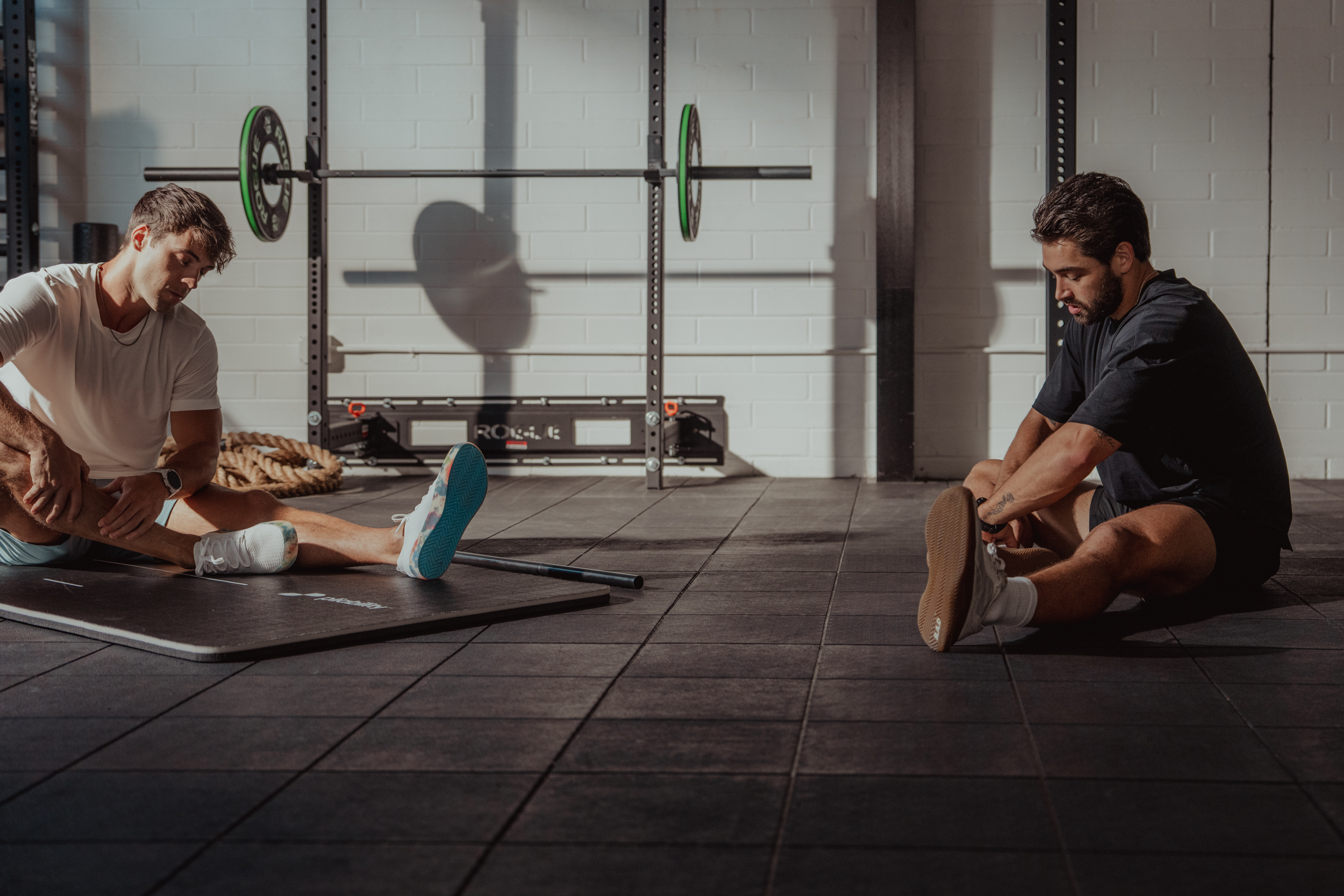
When setting goals, it's common to make the mistake of making them vague. "My goal is to lose weight." This method of goal setting automatically sets you up for failure. This is where the setting is.
SMART goals come into play. A SMART goal is a method of creating a goal that makes a clear roadmap for success. It can help keep you motivated and on track. The acronym SMART goal stands for:
Specific
Instead of a vague goal like "get in shape," a SMART goal is specific to the outcome desired. Instead, it might be "run a 5K without stopping within six months" or "lift 20lb dumbbells for 3 sets of 10 reps by June."
Measurable
SMART goals are easily quantified through numbers, dates, or milestones. This makes tracking progress easier to assess success.
Achievable
Making a goal attainable is highly important. A SMART goal is challenging yet realistic. Set challenging but realistic goals.
Relevant
To keep your motivation, a SMART goal aligns with your interests and desires. This increases your chances of success as it feeds your motivation.
Time-bound
Procrastination is your worst enemy when it comes to achieving your goals. SMART goals counteract this by including deadlines to create urgency. They have specific dates or durations to keep you accountable.
Why SMART Goals Are Important for Flexibility
SMART goals are essential for fostering flexibility, enabling you to adapt to changing circumstances while maintaining focus on objectives. Specific goals provide clarity on desired outcomes, guiding you through evolving situations with confidence. Measurable goals allow for objective progress assessment, even in dynamic environments, ensuring accountability and stability amid uncertainty.
Moreover, achievable, relevant, and time-bound goals promote agility and responsiveness. By setting realistic targets within defined time frames and aligning them with evolving priorities, individuals can remain flexible. This flexibility empowers individuals to pivot when necessary, seizing new opportunities and overcoming challenges with resilience and determination.
Types of SMART Goals for Flexibility
When improving flexibility through exercise, setting SMART goals is key. These goals can help you enhance your range of motion, reduce the risk of injuries, and boost your physical performance.
Here are different SMART goals designed to enhance flexibility during exercise:
Range of Motion Goals
Establish clear objectives for increasing flexibility in targeted muscle groups or joints. You can aim to enhance your range of motion by a certain percentage or track progress using assessments like the sit and reach test or shoulder flexibility test.
Consistency Goals
Prioritize incorporating regular flexibility exercises into your workout routine to see long-term progress. Set measurable targets for how often and how long you engage in stretching sessions, like committing to three stretching sessions per week for 20 minutes each time.
Progressive Overload Goals
Challenge your body’s flexibility by gradually increasing the intensity or difficulty of your stretching exercises as you go along. Set realistic targets for advancing to more challenging stretches or holding existing stretches for more extended periods.
Functional Flexibility Goals
Tailor your flexibility goals to align with specific movements or activities that are important for achieving your fitness objectives or daily tasks. For instance, people looking to enhance their performance in a particular sport can establish SMART objectives to boost the flexibility of muscle groups essential for key movements or skills needed in that sport.
Injury Prevention Goals
Emphasize flexibility training as a crucial component of a holistic injury prevention plan to decrease the likelihood of muscle strains, joint injuries, or other exercise-related issues. Individuals can create goals to address flexibility deficiencies in injury-prone areas and incorporate pre-exercise stretching routines or post-workout recovery strategies.
Related Reading
- What is Functional Movement
- Functional Strength Training
- Does Yoga Help With Mobility
- How Long Does It Take to Improve Flexibility
- Why is Range of Motion Important
- How to Fix Tight Hamstrings
15 SMART Flexibility Goals Examples
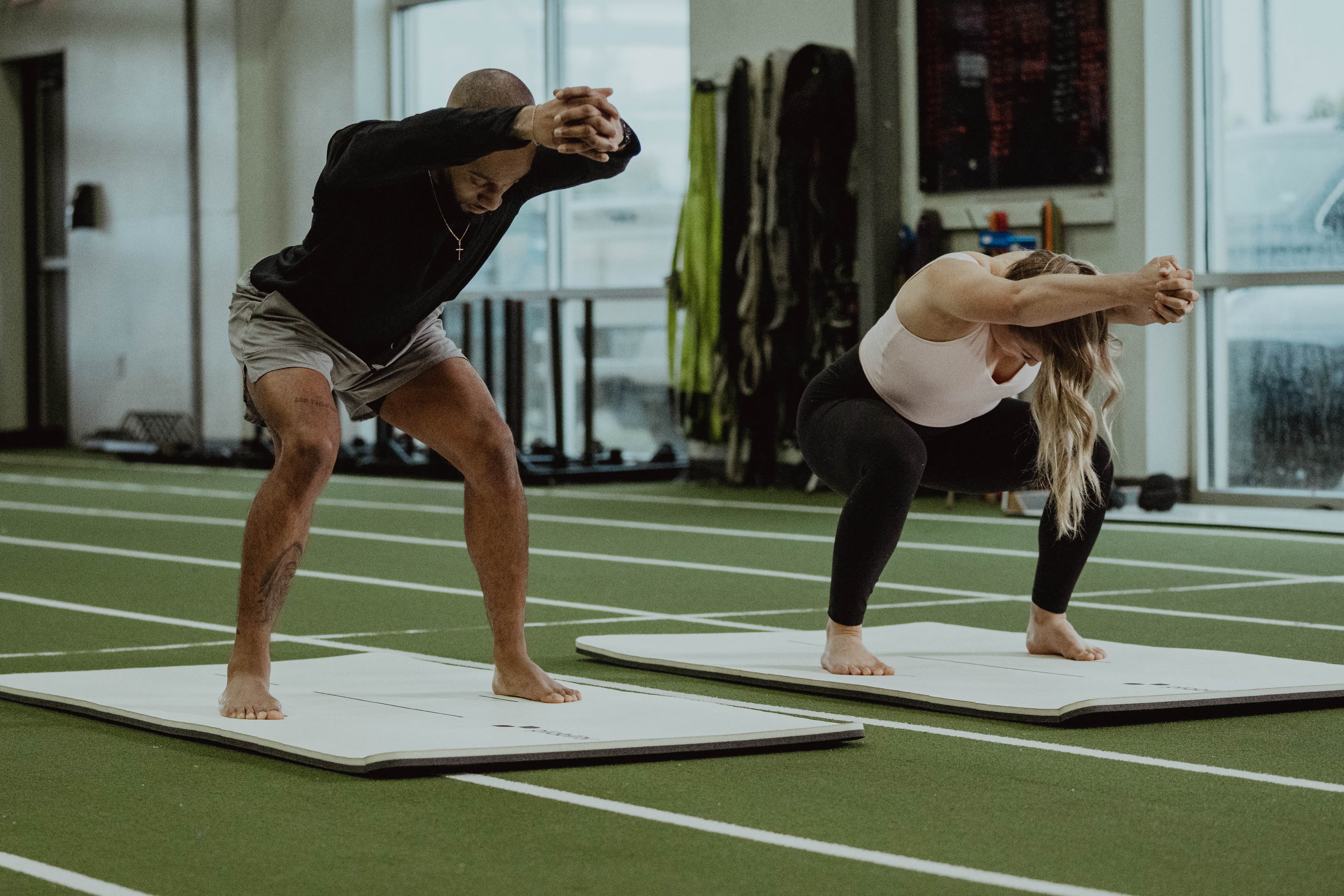
1. Increase Range of Motion
“I’ll increase my range of motion by 10 degrees in each joint within two months through stretching, yoga, and strength training. I’m confident that this will help improve my overall flexibility and increase my athletic performance.”
- Specific: This goal states the expected increase in range of motion and how it will be achieved.
- Measurable: You can measure the degree to which your range of motion has improved before and after goal completion.
- Attainable: Increasing the range of motion by 10 degrees within two months is possible with the proper stretching and exercise plan.
- Relevant: Improving range of motion helps increase flexibility and athletic performance.
- Time-based: Success should occur within two months.
2. Improve Your Balance
“To improve my balance, I will begin attending weekly yoga classes by the end of two months. I plan to focus on developing a strong foundation of balance and stability in my practice.”
- S: The goal is well-defined, detailing the objective and how it will be accomplished.
- M: You can track your progress in improving balance by attending weekly yoga classes.
- A: This particular statement is possible by attending yoga classes.
- R: The SMART goal is pertinent because it will help the individual build strength and stability, which are essential components of overall fitness.
- T: There is a two-month end date for reaching this target.
3. Practice Dynamic Stretching
“I want to incorporate dynamic stretching into my daily routine within the following two months. I hope to increase my range of motion, reduce tightness and muscle tension, and improve my overall flexibility.”
- S: You’ll regularly add dynamic stretching to your daily routine.
- M: Keep track of the days you incorporate dynamic stretching into your routine.
- A: Dynamic stretching is accessible to almost everyone and can be done regularly over time.
- R: This goal is relevant to your primary objective of improving your flexibility.
- T: You should expect goal attainment within two months.
4. Reduce Muscle Soreness
“I’ll reduce my muscle soreness by stretching and foam rolling for at least 10 minutes daily over the one month ahead. I expect to be able to move more easily without muscle soreness.”
- S: This is about taking specific actions, such as stretching and foam rolling, to reduce muscle soreness.
- M: You should dedicate 10 minutes daily to stretching and foam rolling.
- A: This goal is realistic because it outlines manageable actions for a month.
- R: Flexibility and movement without muscle soreness are essential for health, so this is appropriate.
- T: Success needs to be achieved within 8 months.
5. Prevent Injury Risk
“I’ll take the necessary steps to improve my flexibility by attending yoga classes and using proper form during workouts. I’ll do this for half an hour thrice weekly to reduce the risk of injury for 8 months.”
- S: This is explicit as the person mentions yoga classes, workout forms, and frequency.
- M: Check your progress regularly to ensure you reach the desired result.
- A: This SMART goal is achievable if the person takes the necessary steps to improve their flexibility.
- R: Improving flexibility is vital to prevent injuries while working out or playing sports.
- T: The statement must be achieved within 8 months.
6. Be More Patient
“I will commit to a regular fitness routine and gradually increase my flexibility over three months. I’ll focus on being patient and not rushing through my exercises, which should benefit me in the long run.”
- S: The goal names an activity and what time frame it will take place.
- M: You could assess the progress of your flexibility routine.
- A: Committing to a fitness routine and increasing flexibility over three months is doable.
- R: This statement is pertinent to enhancing your overall flexibility.
- T: You have three months to complete this goal.
7. Decrease Back Pain
“I will conduct regular office ergonomic assessments to minimize back pain and other physical issues related to sedentary work within two months. I’ll adjust my workspace to ensure I’m comfortable and able to work without unnecessary physical strain.”
- S: This SMART goal is explicit because it discusses how the person will reduce back pain.
- M: You can assess progress by recording the office ergonomic assessments and workspace adjustments.
- A: This is attainable if you follow an ergonomic office assessment plan and make the necessary adjustments.
- R: Back pain caused by sedentary work is a real issue, so this goal is appropriate.
- T: The person expects to achieve this goal within two months.
8. Improve Your Posture
“I’ll practice proper posture while sitting and standing for 10 minutes daily over the next three months. I plan to schedule regular check-ins with a physical therapist to ensure I’m making progress and that my body is staying healthy.”
- S: The individual will practice proper posture for at least 10 minutes daily.
- M: Monitor progress by scheduling regular check-ins with a physical therapist.
- A: Ten minutes daily is realistic and manageable for most people to work on their posture.
- R: Good posture helps to improve flexibility and reduce pain.
- T: There is a three-month window to reach the goal statement.
9. Strengthen Core Muscles
“I want to improve my flexibility and posture by strengthening the core muscles. By the end of two months, I aim to perform core exercises four times a week and increase the difficulty level as each exercise gets easier.”
- S: The goal is clear. The individual must strengthen their core muscles to enhance flexibility and posture.
- M: You’ll perform core exercises four times a week and increase the difficulty level as each exercise gets easier.
- A: This is doable if given the necessary resources and time.
- R: The goal is appropriate for the individual’s desire to improve flexibility and posture.
- T: Goal attainment will be met after two whole months.
10. Maximize Physical Potential
“I’ll strive to optimize my physical potential by stretching and breathing exercises every day for the next three months. This will help with my overall body flexibility and reduce any physical pain I’m experiencing.”
- S: You aim to optimize physical potential by performing daily stretching and breathing exercises.
- M: This goal regarding physical strength, flexibility, and pain reduction can be measured.
- A: This is an achievable goal because it involves consistent daily practices.
- R: The goal is suitable because it aims to improve physical performance and reduce pain.
- T: The statement is time-bound because it has an end date of three months.
11. Boost Body Awareness
“I will attend two yoga classes and practice 15 minutes of stretching daily to improve my body awareness within two months. I hope to develop a more mindful approach to my body and how it moves.”
- S: The SMART goal is explicit because it specifies the types of activities to do.
- M: You could count the classes you attend and the minutes you stretch.
- A: Attending two yoga classes and stretching for 15 minutes a day is feasible.
- R: Boosting body awareness through yoga and stretching relates to flexibility.
- T: Goal attainment is anticipated after two whole months.
12. Enhance Your Quality of Life
“I’ll strive to improve my quality of life by incorporating one new fitness activity each month for the next year. I want the strength, flexibility, and endurance to pursue activities I enjoy.”
- S: The goal is easy to understand, outlining what activity will be taken on each month.
- M: You measure the quality of life improvement, such as how the individual feels and how they progress with their fitness.
- A: The aim is to improve your quality of life, which is possible by taking on a new fitness activity monthly.
- R: Fitness activities improve your physical and mental health, so this goal will positively affect your quality of life.
- T: This goal statement has a timeline of one year to accomplish.
13. Incorporate ISO stretching at least once a week
“I will incorporate isometric stretching into my routine at least once a week for the next 8 weeks to improve muscle flexibility and control.”
- S: The goal is specific: add isometric stretching to your routine once a week.
- M: You can track each week you complete the ISO session.
- A: Once per week is realistic and manageable for most fitness levels.
- R: Isometric stretching directly supports flexibility and muscle engagement.
- T: The time frame is set at 8 weeks.
14. Hold a crow pose for 30 seconds within 3 months
“I will practice arm balances twice a week to hold a crow pose for 30 seconds within 3 months, improving both balance and core strength.”
- S: The goal clearly defines the pose and duration.
- M: Progress can be tracked by measuring how long you can hold the pose each week.
- A: With regular practice, holding the crow pose for 30 seconds is attainable in 3 months.
- R: This goal targets strength, stability, and flexibility, all relevant to overall mobility.
- T: The timeline is three months.
15. I will perform my stretching routine three times a week and record a video selfie of progress once a week
“I will follow my full-body stretching routine three times a week and record a weekly video selfie for 10 weeks to track my flexibility improvements visually.”
- S: The plan outlines a specific routine and method of tracking progress.
- M: You can measure adherence by tracking sessions and weekly videos.
- A: Three sessions and one video per week is a manageable and motivating structure.
- R: Regular stretching and visual feedback support improved flexibility and accountability.
- T: The 10-week timeframe gives structure and a deadline for progress review.
Related Reading
- How to Get a Crook Out Your Neck
- Loss of Mobility
- How Does Flexibility Work
- Flexibility Gymnastics
- Are Women More Flexible Than Men
- What is the Impact of Age on Flexibility
- What is Passive Stretching
Where To Start With Flexibility? (Routines For Beginner to Advanced)
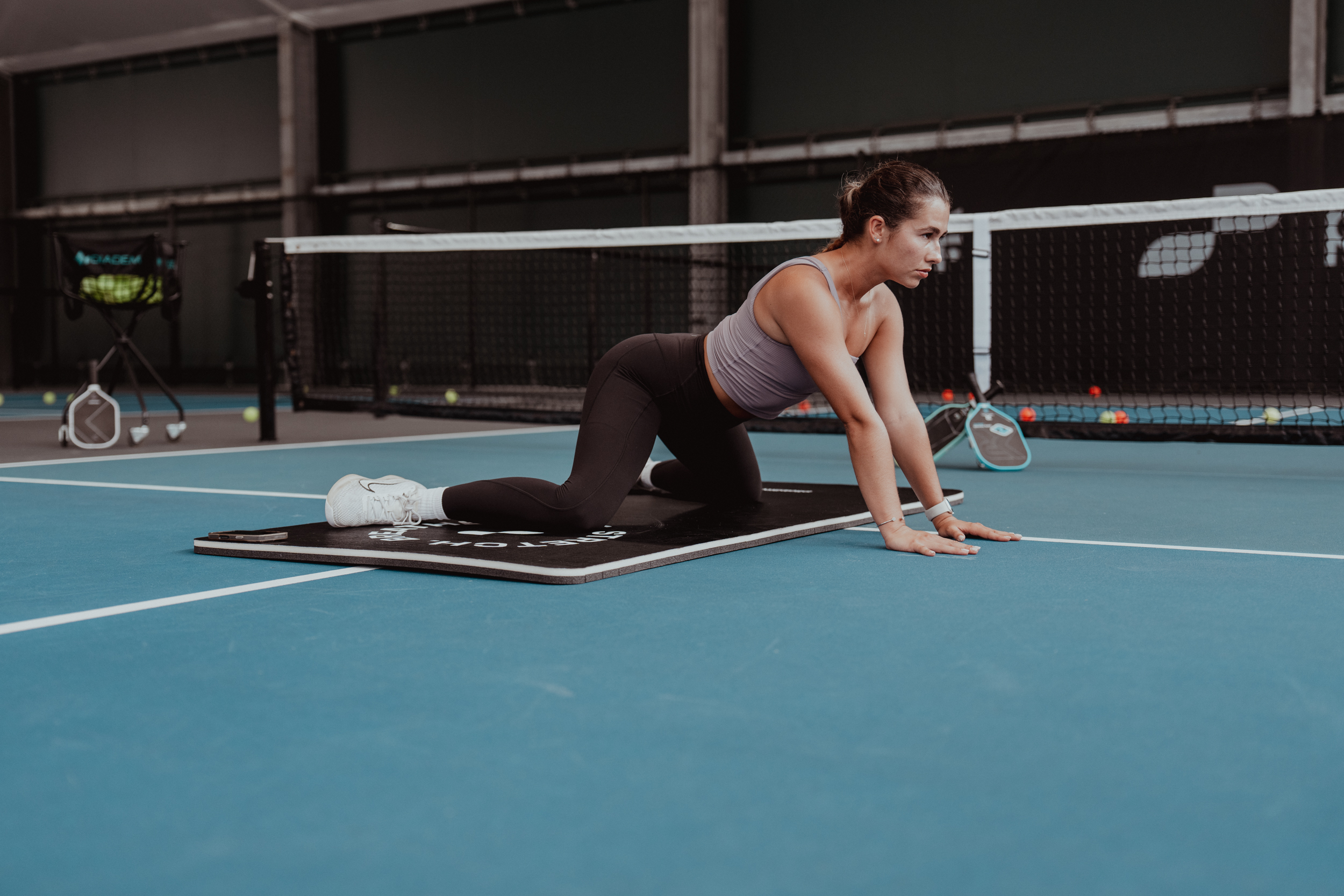
Developing flexibility is not something that happens overnight, over a few days, or even weeks, for that matter. Like any training pursuit, the key is a combination of using the right tools and long-term consistency.
The Basic Formula
To grease the groove of flexibility, we need to introduce daily variability, or GtG, routines to increase the range of motion and tolerance to stretching. Next, we need to add focused, intense stretching routines that will provide measurable, targeted progress toward specific flexibility goals.
Combining both of these approaches will make for a simple and effective flexibility training plan that can be easily integrated into your current training program.
Greasing the Groove
Flexibility isn’t something that just comes about after a bit of stretching; you need to either use it or lose it. For this reason, it is helpful to have some sort of daily, or close to, greasing the groove and using the range of motion.
This can just be part of your regular training or day-to-day activities if you’re required to use your flexibility, such as with bodyweight training. Where this isn’t the case and you’ve spent a little too long sitting watching Netflix, then you need to inject it in artificially.
Quick Flexibility Fixes
This could be a quick and straightforward routine, like the 5-minute morning mobility routine, or a more comprehensive 20-minute beginner routine. I also like more dynamic techniques like leg kicks and arm swings. Do it first thing in the morning, as a work break, post training or before bed. The important thing is to do!
Focused Intensity
General stretching is great for greasing the groove (GtG), but it is slow to develop flexibility long-term because the adaptation is broad. Therefore, you make small progress in many facets. To speed things up, it is essential to add some focused and higher-intensity stretching. In most instances, THIS is the cake and the GtG is the cherry on top.
These sessions will provide the biggest jumps in range of motion and progress with the GtG, keeping things ticking over between. These sessions can be chosen based on your goals, whether that is developing a better pike, splits, pancake, or anything else in between.
Example 1: Beginner
As a beginner, it does not necessarily mean you’re tight, but just new to stretching, but the two tend to go hand in hand. The most important thing is to start doing and learn to tolerate the stretch reflex better.
Embrace the Stretch: Beginner GtG + Hamstring Focus
Stretching isn’t fun (depending on your level of masochism) and will be uncomfortable. Much of getting more flexible initially comes from being better able to tolerate the stretch reflex, otherwise known as Embracing The Suck!
For a routine, follow the above formula at a level you can manage. A good starting place would be using one of the beginner's follow-along routines as your GtG. This will complement the main focused intense session, which would be targeted at developing the hamstrings.
Hamstring First: The Key to Unlocking Flexibility
I recommend using the hamstrings as the focus for beginners, as improving this helps unlock the lower body and provide a good base to develop other key patterns. I suggest passing these 3 tests to build a well-rounded base of flexibility.
The beginner hamstring flexibility routine is a great loaded routine, and there is a 15-minute hamstring flexibility routine for those who prefer the follow-along format. All together it would look something like this:
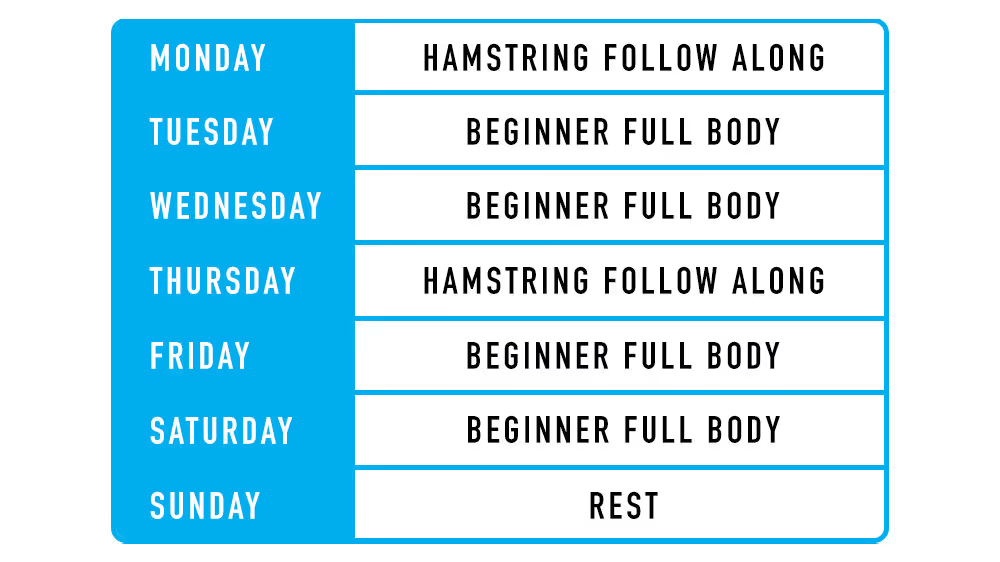
Example 2: Strength + Flexibility (Intermediate)
Once we begin to develop some basic levels of flexibility, we can move on to some more advanced techniques. This is my favourite way of incorporating flexibility training as a pairing of both strength and flexibility. These routines focus on developing mobility over flexibility. It is about building strength and control through a full range of motion.
This setup is based around an upper and lower body split being performed twice per week. These count as the intense and focused sessions, so only a couple of additional GtG sessions would be needed on top. For most people, this is where you’ll realise the potential for your flexibility and make significant progress.
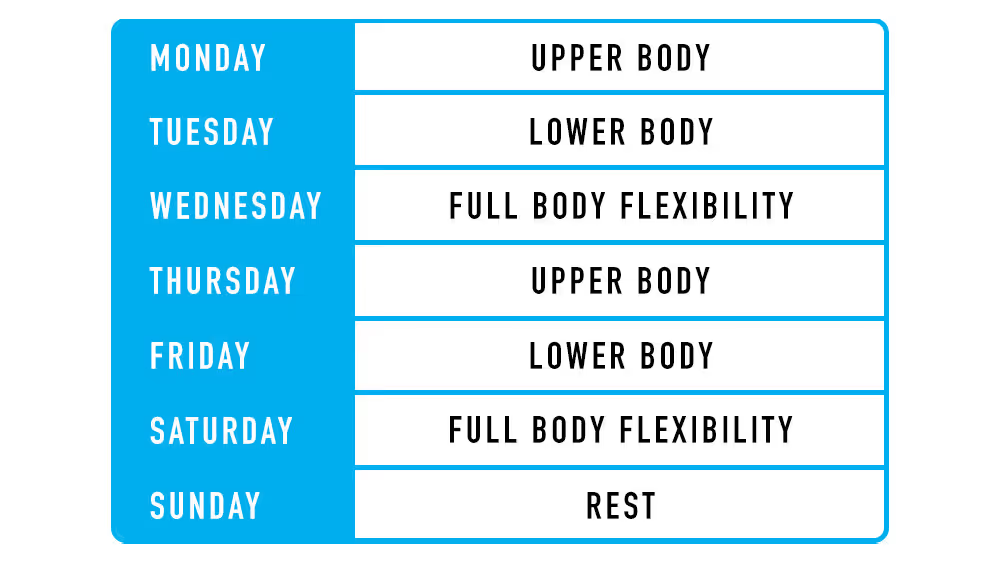
Example 3: Advanced Positions
Now we get to the fun (or not so fun) stuff. Developing splits or advanced flexibility positions takes time. How long? Well, I addressed my progress in this video on how long mobility takes. It also requires specific work, which is where this example comes in. The same above formula applies with some daily GtG and focused, intense sessions for whatever your goals are.
I will add the links to specific routines below, but I would also recommend watching the Do It Right series to get some form cue recommendations and check your training things optimally.
Combining Everything
This can get tough for those wanting to achieve advanced flexibility. Below are a couple of example options. The first is for those wishing to attain middle splits and pancake. As these positions are similar and share a familiar pattern, they can be trained together following a twice-weekly focus.
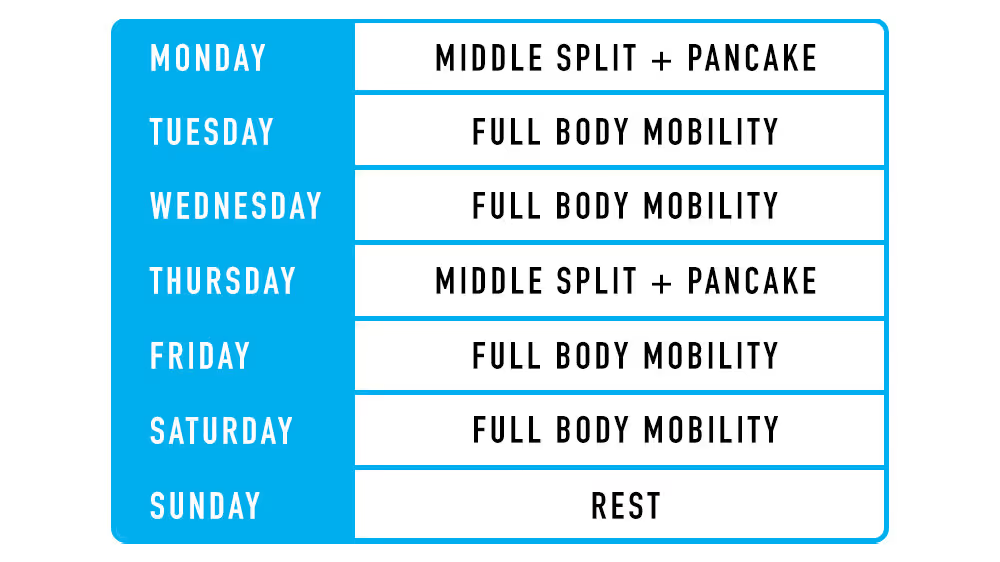
If you want to add a front split into the mix, then I suggest splitting sessions. This would follow a 3x per week structure where you alternate between workouts is an A B A B A B etc fashion.
Improve Your Flexibility with Our Mobility App Today | Get 7 Days for Free on Any Platform

Pliability offers a fresh take on yoga, tailored for performance-oriented individuals and athletes. Our app features a vast library of high-quality videos designed to improve flexibility, aid recovery, reduce pain, and enhance range of motion.
Move Better Daily with Pliability’s Custom Mobility App
Pliability provides daily-updated custom mobility programs for those interested in optimizing their health and fitness. It also includes a unique body-scanning feature to pinpoint mobility issues.
If you're feeling limited by pain or the ability to move, Pliability aims to complement your existing fitness routine and help you move better. Sign up today to get 7 days absolutely for free, on iPhone, iPad, Android, or on our website to improve flexibility, aid recovery, reduce pain, and enhance range of motion with our mobility app.
Related Reading
- What is Static Exercise
- Dynamic Movement
- Why Does Stretching Hurt
- Yoga Poses for Flexibility
- Hip Opening Yoga Poses
- Proprioception Exercises
- Neck Mobility Exercises
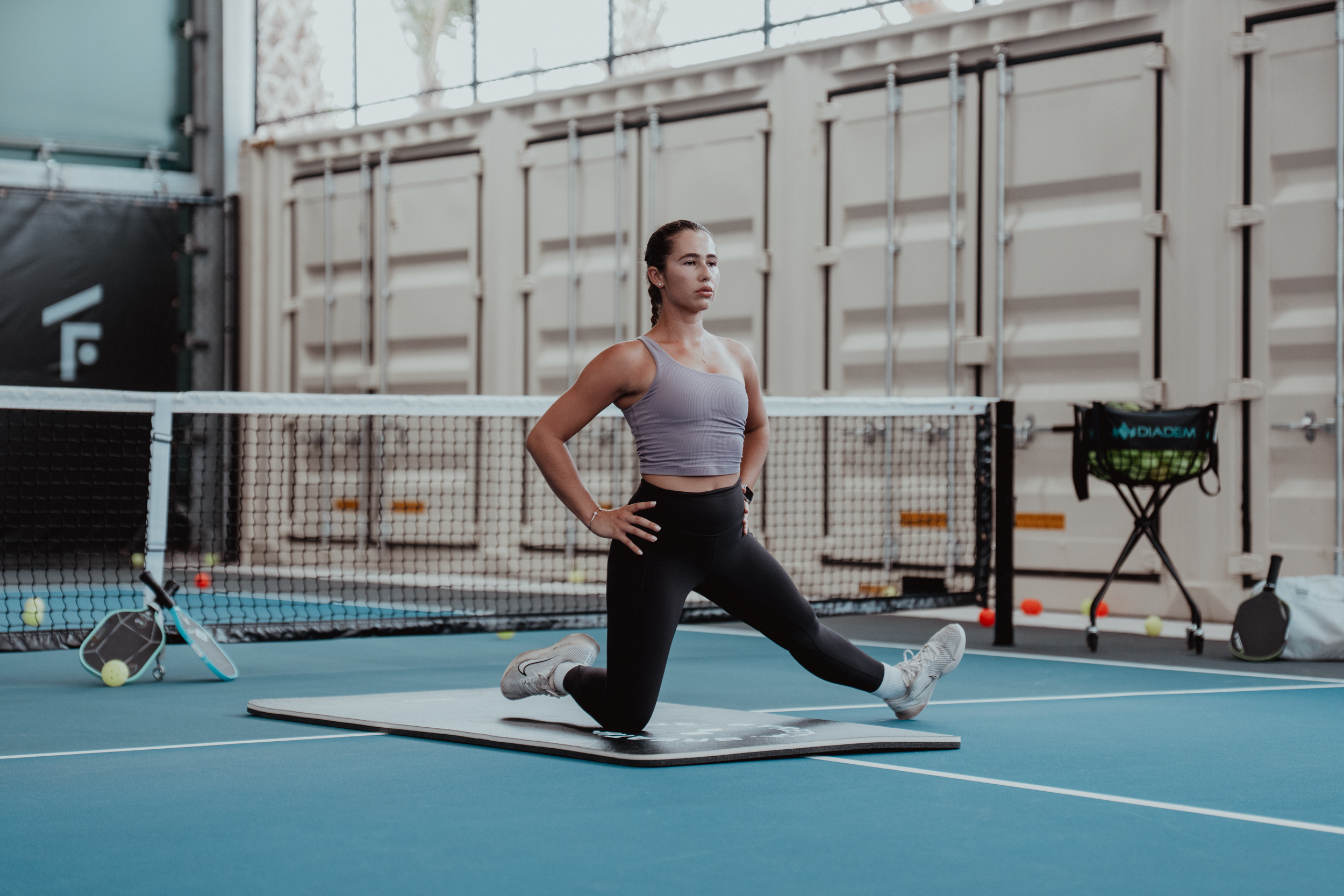
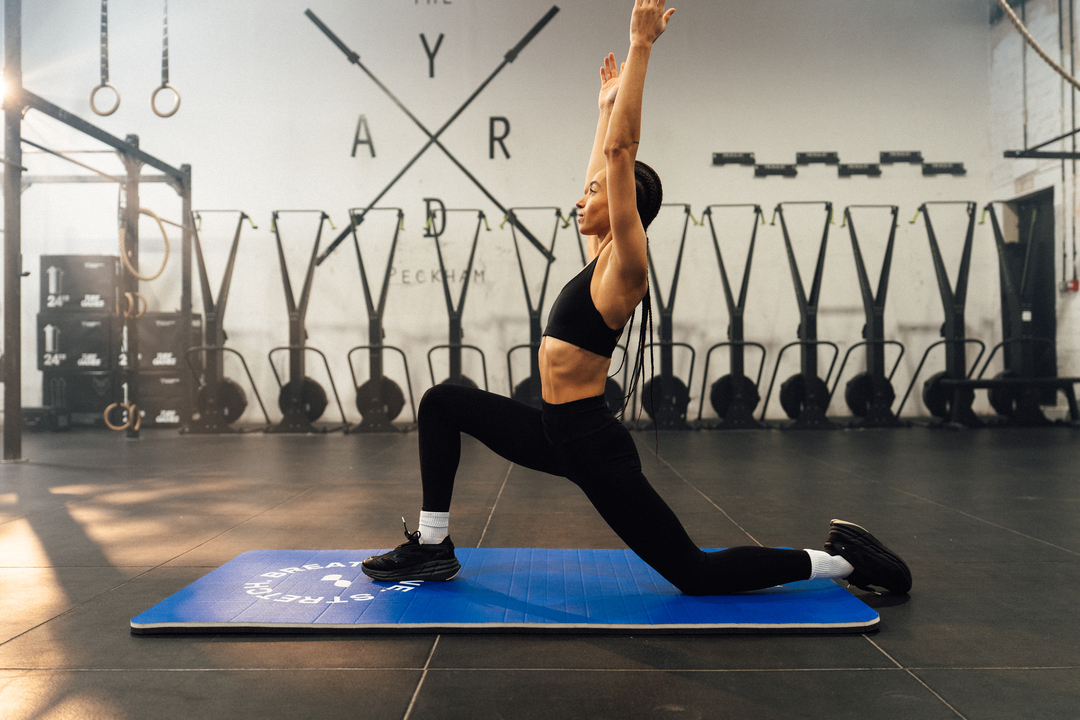

.jpg)
.jpg)
.jpg)


